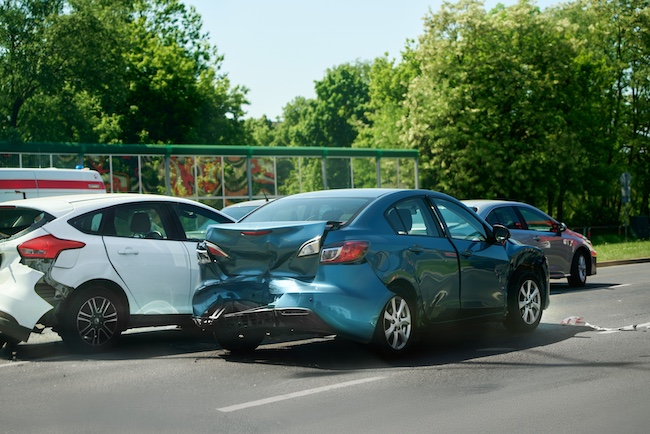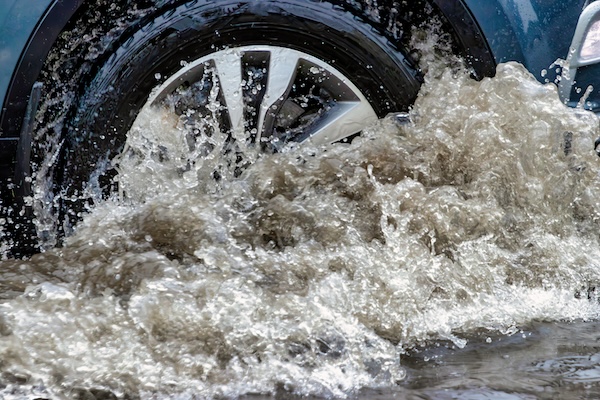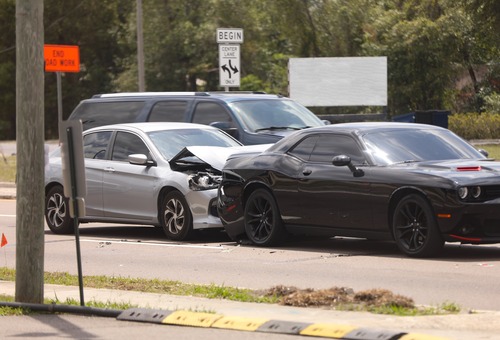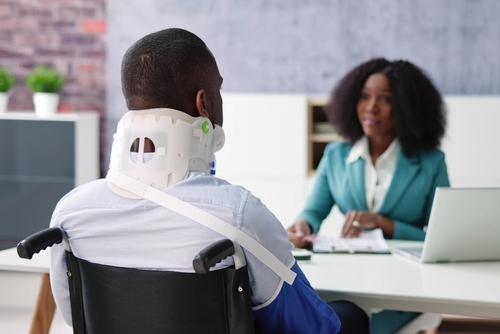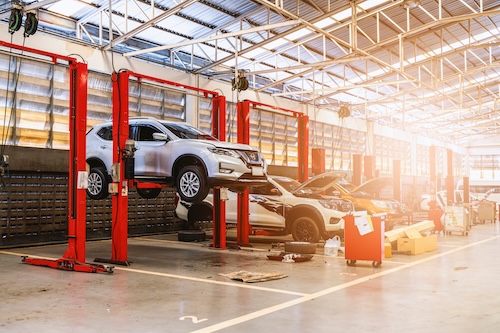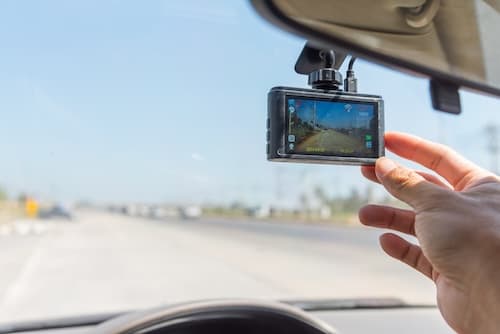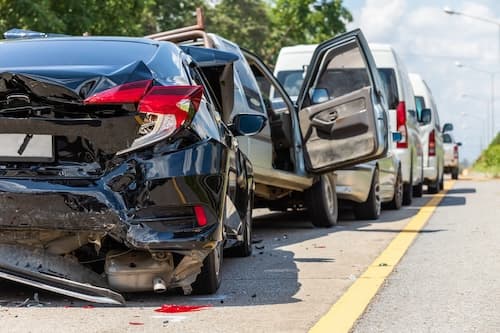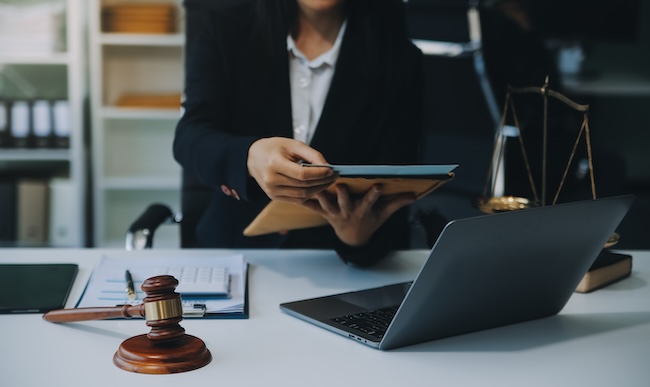Understanding Liability in Rear End Collisions
Rear end collisions are one of the most common types of traffic accidents, and determining fault can be more complicated than many drivers expect. If you’ve been injured in one of these crashes, consulting with an experienced car accident lawyer at Ross Moore Law can make all the difference in protecting your rights and securing the compensation you deserve.
Whether you’ve suffered injuries, are facing mounting medical bills, or need help proving fault against the other driver, legal guidance is critical in these often complex situations.
Why Rear-End Collisions Matter
According to the National Highway Traffic Safety Administration, rear end collisions make up nearly one-third of all traffic accidents in the United States.
Most rear end accidents occur at stoplights, intersections, or during sudden stops in highway traffic. The vehicles involved may sustain significant property damage, and victims often suffer injuries ranging from soft tissue injuries to spinal cord injuries.
What makes rear end crashes especially frustrating is that many drivers assume the rear driver is always at fault. While this is often true, it isn’t always the case — factors like aggressive driving behaviors, poor weather conditions, and even mechanical failures can shift liability.
Common Causes of Rear-End Collisions
Aggressive Driving Behaviors
Aggressive driving behaviors also rank among the leading causes of rear end crashes. Many drivers fail to respect speed limits, follow too closely behind the vehicle ahead, or engage in sudden lane changes without signaling. In some cases, road rage plays a role, with one driver deliberately brake checking another, creating a high risk of a rear end collision. When aggressive driving behaviors are involved, the rear driver is usually considered the at fault driver because their actions directly violate traffic safety laws.
What makes these accidents more complex is that they often involve multiple vehicles in chain reaction crashes. For example, if a speeding rear driver hits the front vehicle and pushes it into another car, determining fault can require analyzing each vehicle’s movement, witness accounts, and skid marks at the accident scene.
In many rear end accidents caused by aggressive driving, victims suffer severe injuries or permanent injuries that require medical attention, physical therapy, or even lifelong treatment. These reckless choices put many drivers at risk and lead to auto accidents that could have been avoided with safer driving habits.
Poor Weather Conditions and Mechanical Failures
Another common set of causes for rear end accidents involves environmental factors and mechanical issues. Poor weather conditions such as rain, snow, ice, or heavy fog reduce visibility, make brake lights harder to see, and create slippery roads that increase stopping distances. Accident reports often note skid marks left by a following vehicle that attempted to stop but could not avoid striking the leading vehicle. Sudden stops in poor weather are especially dangerous, and they frequently result in chain reaction collisions involving multiple vehicles.
Mechanical failures also contribute to many rear end collisions. Faulty brakes, worn tires, and malfunctioning brake lights can prevent the rear driver from stopping in time or prevent the front driver from signaling properly to vehicles behind them.
In some situations, the rear driver may not be entirely at fault if a mechanical failure on the front vehicle contributed to the crash. Proving fault in these cases often requires expert testimony, mechanical inspections, and strong legal representation to demonstrate that negligence or lack of vehicle maintenance played a role.
When victims suffer accident injuries due to poor weather conditions or vehicle defects, insurance companies often try to deny liability or minimize payouts. This makes it essential to consult with a personal injury lawyer who understands how to prove fault, establish liability, and pursue maximum compensation for medical bills, lost wages, property damage, and long-term care.
Distracted Driving
One of the most frequent causes of rear end collisions is distracted driving, a problem that continues to rise despite stricter traffic rules and public awareness campaigns. Drivers often take their eyes off the road to send a quick text, glance at their GPS, adjust the steering wheel, or even check on passengers in the back seat. In those few seconds of inattention, the vehicle ahead may hit the brakes, slow down for a traffic signal, or stop completely.
When that happens, the rear driver has little to no reaction time, resulting in a rear end car accident. Accident scene investigations often reveal cellphone records, testimony from the other driver, or a police report noting distraction as a factor. Even when the distracted driver insists they were paying attention, evidence such as skid marks, lack of evasive maneuvers, or failure to notice brake lights can demonstrate negligence.
Distracted driving not only causes property damage but frequently leads to serious injuries such as whiplash, head injuries, and soft tissue injuries, forcing victims to seek compensation through a personal injury lawsuit.
Injuries Sustained in Rear-End Accidents
The injuries sustained in rear end collisions can range from minor to catastrophic.
- Soft tissue injuries: whiplash, muscle strains, ligament tears.
- Head injuries: concussions, traumatic brain injuries.
- Spinal cord injuries: herniated discs, nerve damage, permanent paralysis.
- Broken bones and fractures.
Even in a seemingly minor auto accident, serious injuries can occur. Victims often need medical attention, extensive physical therapy, and time off work. The resulting medical bills and lost wages can be financially devastating. That’s why consulting a personal injury lawyer is essential after any rear end car accident.
Determining Fault in Rear-End Collisions
Presumption of Fault
In the majority of rear end collisions, the legal system, insurance companies, and courts begin with the presumption that the rear driver is the at fault driver. The reasoning is grounded in basic traffic rules: every driver has a duty to maintain a safe following distance, obey posted speed limits, and remain alert for sudden stops by the vehicle ahead. When the following vehicle fails to slow down or stop in time, causing a rear end car accident, it is typically evidence of negligence.
This presumption of fault is not just a legal technicality — it’s also supported by accident reconstruction experts and law enforcement officers who investigate the accident scene. They often find skid marks, evidence of distracted driving, or a lack of evasive maneuvers by the rear driver. For victims who suffered injuries, this presumption can simplify the process of pursuing a personal injury lawsuit or negotiating an insurance claim. Still, it is important to remember that fault is not always automatic, and every case must be examined on its own facts.
Exceptions to the Rule
Not every rear end collision fits neatly into the assumption that the following vehicle is entirely responsible. Courts and insurance adjusters recognize multiple scenarios where the front driver or even other drivers may share liability.
One common example is brake checking, where a driver intentionally slams on the brakes to punish or intimidate the following vehicle. This aggressive driving behavior can make the front driver partially responsible for the crash. Similarly, sudden stops without reason — such as a driver halting in the middle of the road when traffic is clear — can shift some of the blame away from the rear driver.
Unsafe lane changes are another leading cause of end collisions. If a front vehicle cuts directly in front of a following vehicle without leaving adequate space, the resulting crash may place fault on the front driver for creating an unavoidable hazard.
Finally, chain reaction crashes add another layer of complexity. In a multi-vehicle pileup involving multiple drivers, liability may be distributed among several vehicles depending on speed, weather conditions, and whether each driver maintained a safe following distance.
These exceptions demonstrate why determining fault requires more than simply assuming the rear driver is always responsible. Each situation must be carefully analyzed to identify the true cause of the rear end accident.
Evidence at the Accident Scene
When it comes to proving fault, evidence from the accident scene is critical. A police report often serves as the starting point, documenting the time, location, vehicles involved, and observations about weather conditions, traffic signals, and road hazards. Officers typically note whether skid marks were present, whether brake lights were working, and whether any driver admitted fault.
In addition to the official report, photos of vehicle damage, airbag deployment on the steering wheel, or malfunctioning brake lights can provide compelling evidence. Eyewitness testimony from bystanders or other drivers also helps establish what actually occurred during the collision.
In more serious cases, accident reconstruction experts may analyze physical evidence such as skid marks, impact angles, and debris patterns to determine the sequence of events.
All of this evidence plays a critical role not only in proving fault but also in countering claims by the insurance company that may attempt to shift blame or minimize liability. Without strong documentation, victims risk losing out on the maximum compensation they deserve for their injuries and financial losses.
Insurance and Legal Considerations
Dealing with the Insurance Company
After a rear end accident, victims typically must report the crash to their own insurance company and, in many cases, the other driver’s insurance company as well. Filing an insurance claim is rarely simple. Insurers often attempt to reduce payouts by downplaying the severity of injuries sustained, arguing that the vehicle damage is minor, or even suggesting the victim was partially at fault due to sudden stops or poor vehicle maintenance.
Negotiating with the insurance company can be overwhelming, especially for those dealing with serious injuries, mounting medical bills, and time away from work. Adjusters are trained to protect their bottom line, not the best interests of accident victims. That’s why having clear evidence, medical records, and legal representation is so important when pursuing compensation for accident injuries.
Legal Representation and Lawsuits
For many victims of rear end collisions, the best way to secure justice is by working with an experienced personal injury lawyer. At Ross Moore Law, we understand the tactics insurance companies use and how to build a strong case on behalf of injured clients. Legal representation is particularly important when permanent injuries, spinal cord injuries, or long-term physical therapy are involved.
A skilled attorney can calculate damages that extend beyond immediate medical bills to include lost wages, reduced earning capacity, and future care needs. They can also use the police report, accident reconstruction evidence, and witness statements to prove liability. If negotiations with the insurance company fail, a personal injury lawsuit may be necessary to ensure victims recover the maximum compensation they are entitled to.
For those who have suffered severe injuries, legal options provide a path forward, allowing them to focus on healing while their legal professional handles the fight for fair compensation. At the end of the day, the goal of pursuing a claim is not just about financial recovery — it’s about restoring dignity, holding negligent drivers accountable, and helping accident victims regain stability after life-changing auto accidents.
Preventing Rear-End Accidents
Safer Driving Practices
While no driver can control the actions of others, practicing defensive driving can reduce the risk of rear end crashes. Key safety tips include:
- Maintaining a safe distance from the vehicle ahead.
- Avoiding aggressive driving behaviors such as tailgating and sudden lane changes.
- Paying close attention to brake lights and potential hazards.
- Obeying speed limits and local traffic rules.
Technology and Awareness
Modern safety features like automatic emergency braking and collision warning systems are reducing the number of rear end collisions. Still, many drivers neglect basic safe driving habits, leading to preventable traffic accidents.
Frequently Asked Questions About Fault in Rear End Collisions
Who is usually at fault in a rear end collision?
In most rear end collisions, the rear driver is presumed to be at fault because traffic rules require maintaining a safe distance from the vehicle ahead. When the following vehicle strikes the front vehicle, it often means the rear driver was speeding, distracted, or engaging in aggressive driving behaviors.
Courts, insurance companies, and police reports generally view the rear driver as the at fault driver, but every accident scene is different and evidence is critical in proving fault.
Can the front driver ever be at fault in a rear end accident?
Yes, while many drivers assume liability always falls on the rear driver, there are situations where the front driver or other driver can share responsibility. Examples include sudden stops without cause, brake checking, unsafe lane changes, or mechanical failures like faulty brake lights. In these cases, determining fault requires a detailed investigation of the accident injuries, vehicle damage, skid marks, and the police report.
How do insurance companies determine fault in rear end collisions?
Insurance companies examine the accident scene, the police report, statements from multiple drivers, and evidence like skid marks or damage to the vehicles involved. They look at whether the rear driver was distracted, whether the front driver made sudden lane changes, and whether poor weather conditions or mechanical failures played a role.
Ultimately, the insurance company may try to minimize payout, which is why legal representation from a personal injury lawyer can be essential to securing maximum compensation.
What if multiple vehicles are involved in a chain reaction collision?
When rear end collisions involve multiple vehicles, they often become chain reaction crashes. In these situations, determining fault becomes more complicated because multiple drivers may have contributed to the accident.
For example, if a following vehicle strikes the leading vehicle and pushes it into another car, the rear driver may be primarily at fault, but other drivers may share liability depending on sudden stops, speed limits, or aggressive driving behaviors. Legal professionals use evidence from the police report, accident scene photographs, and testimony to establish who is responsible.
What evidence helps prove fault in a rear end car accident?
The most important evidence includes the official police report, photographs of vehicle damage, visible skid marks, witness statements, and in some cases, traffic camera footage. Evidence of brake lights not working, sudden lane changes by the front driver, or steering wheel airbag deployment can all affect determining fault.
Collecting this documentation immediately after seeking medical attention for injuries sustained is crucial for proving fault in a personal injury lawsuit.
Can I seek compensation if I suffered injuries in a rear end collision?
Yes, if you suffered injuries such as whiplash, head injuries, broken bones, spinal cord injuries, or other physical injuries, you may be entitled to compensation. Filing an insurance claim or pursuing a personal injury lawsuit with the help of a personal injury lawyer allows victims to recover damages for medical bills, lost wages, physical therapy, property damage, and even permanent injuries.
An experienced legal professional can guide you through your legal options, negotiate with the insurance company, and help you secure the maximum compensation available.
Are rear end collisions always considered preventable accidents?
Most rear end accidents are preventable, which is why they are one of the leading causes of auto accidents nationwide. Following traffic rules, avoiding distracted driving, respecting speed limits, and steering clear of aggressive driving behaviors can significantly reduce the likelihood of being involved in one. However, when other drivers fail to act responsibly or sudden weather conditions create hazards, even the safest drivers may become victims of rear end crashes.
Protecting Yourself After a Rear-End Collision
Rear end collisions can result in devastating accident injuries, high medical bills, and lasting trauma. Whether caused by distracted driving, aggressive driving, or poor weather conditions, it’s vital to understand your rights.
At Ross Moore Law, our experienced team of legal professionals helps victims navigate the challenges of dealing with the insurance company, documenting the accident scene, and filing a personal injury lawsuit when necessary. With strong legal representation, you can seek fair compensation for injuries sustained, lost wages, and long-term care needs.
If you or a loved one has suffered injuries in a rear end car accident, don’t wait. Contact Ross Moore Law today 404-445-8122 for trusted legal guidance and the support you need to move forward.
